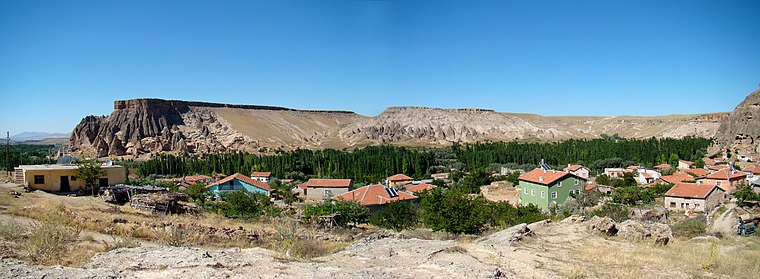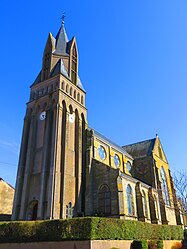일라라
Ihlara일라라 | |
|---|---|
타운쉽 | |
 일라라 계곡 위로 보기 | |
 터키 내 Ihlara의 위치. | |
| 나라 | |
| 지역 | 중앙 아나톨리아 |
| 주 | 악사라이 |
| 시간대 | UTC+2(EET) |
| • 여름(DST) | UTC+3(EEST) |
| 우편번호 | 68xx xx |
| 번호판 | 68 |
| 웹사이트 | www.ihlara.bel.tr |
이흘라라는 터키 중부 아나톨리아 악사라이 지방에 자치구가 있는 읍이다. 아크사라이 지방 의자에서 약 40km(25mi) 떨어진 곳에 있으며, 구젤리우르트 마을 부근에 위치해 있다. 이 마을은 에르시예스 산이 몇 차례 폭발한 뒤 카파도키아 남부 화산암으로 갈라진 16km(10mi) 길이의 협곡인 이하라 계곡이 유명하다. 멜렌디즈 하천은 계곡을 통해 흐른다.
이흘라라 계곡은 셀리메에서 이흘라라 마을까지 이어지는 남북 멜렌디 강을 따라 14km로 이루어져 있다. 계곡의 105개 교회 중 16개 교회가 방문객에게 개방되어 있으며, 이 중 대부분은 이하라의 공식 계곡 입구에서 1km 이내에 있다. 계곡으로 통하는 계단 밑바닥에 있는 아사살트 킬리스(나무 아래 교회)가 가장 먼저 보인다. 화려한 청색과 흰색의 천사들이 잘 보존된 돔 위에서 그리스도의 형상을 둘러싸고 있다. 아차살트(입구 계단을 내려간 후 오른쪽 벨리시르마에서 떨어져 있음)를 지나 남쪽으로 30m 더 가면 프티렌셀세키 교회가 있는데, 그 교회는 시바스의 많은 순교자들을 둘러싸고 빛바랜 벽으로 둘러싸여 있다. 70m 더 멀리 있는 코코르 킬리스(Odusic Church)는 화려한 프레스코화와 화려한 기하학적 천장 십자가로 성경 이야기를 기념한다.[1]
그 계곡을 독특하게 만드는 것은 그 주민들의 고대 역사다. 협곡 전체는 카파도키아인 그리스인들이 지은 비잔틴 시대부터 바위가 깎인 지하 주거지와 교회들로 벌집이 되어 있다. 이러한 현지인들은 1923년 터키와 그리스 간의 인구 교류에서 이 지역을 떠나 그리스로 이주할 수밖에 없었다.[2][3]
계곡의 풍부한 물 공급과 은신처 덕분에 로마 군인들을 피해 탈출한 최초의 기독교인들이 정착한 것은 이번이 처음이었다. Ihlara 계곡에는 화산암동굴에 수백개의 오래된 교회들이 있다. 가장 잘 알려진 교회는 교차 계획이 있는 아차탈트 교회, 셈벨뤼 교회, 퓌렌리세키 교회, 코코르 교회, 이일란리 교회, 카라게딕 교회, 커크다마틀리 교회, 데렉클리 교회, 알라 교회, 케멜리 교회, 에르기타스 교회 등이다.
참조
- ^ "Ihlara".
- ^ Darke, Diana (2011). Eastern Turkey. Bradt Travel Guides. pp. 139–140. ISBN 978-1-84162-339-9.
The area became an important frontier province during the 7th century when Arab raids on the Byzantine Empire began. By now the soft tufa had been tunneled and chambered to provide underground cities where a settled if cautious life could continue during difficult times. When the Byzantines re-established secure control between the 7th and 11th centuries, the troglodyte population surfaced, now carving their churches into rock faces and cliffs in the Goreme and Sogamli areas, giving Cappadocia its fame today. […] At any rate here they flourished, their churches remarkable for being cut into the rock, but interesting especially for their paintings, relatively well preserved, rich in coloring, and with an emotional intensity lacking in the formalism of Constantinople; this is one of the few places where paintings from the pre-iconoclastic period have survived. Icons continued to be painted after the Seljuk conquest of the area in the 11th century, and the Ottoman conquest did not interfere with the Christian practices in Cappadocia, where the countryside remained largely Greek, with some Armenians. But decline set in and Goreme, Ihlara and Soganli lost their early importance. The Greeks finally ending their long history here with the mass exchange of populations between Turkey and Greece in 1923.
- ^ Rodley, Lyn (2010). Cave Monasteries of Byzantine Cappadocia. Cambridge University Press. p. 1. ISBN 978-0-521-15477-2.
The tenth-century historian Leo the Deacon records a journey to Cappadocia made by Nikephoros Phokas shortly before he became emperor. Perhaps to recapture the attention of readers beginning to tire of troop movements he also offers a scrap of information about a curiosity of the region to which the emperor was heading: its inhabitants were once called troglodytes, because ‘they went underground in holes, clefts and labyrinths, as it were in dens and burrows’. This brief note was probably not based on first-hand knowledge but it might have been prompted by an awareness of the vast number of rock-cut cavities in an area to the west and southwest of Kaisareia (Kayseri of modern Turkey). Had Leo been more inclined to garrulous digression (or perhaps just better informed), he might have supplied more details of the troglodyte region and the task of bringing scholarly order to the hundreds of rock-cut monuments and other cavities in the area might have been much similar. … At this time the region was still inhabited by a mixed population of Turkish-speaking Moslems and Greek-speaking Christians. The latter group left for Greece in the early 1920s, during an exchange of population of minorities that was part of the radical social re-ordering initiated by Mustafa Kemal Atatürk; they were replaced by Turks from Greece, mostly from Thrace. In the two decades before this upheaval, however, members of the local Greek population acted as guides to Guillaume de Jerphanion, who made several visits to the volcanic valleys and wrote his meticulous descriptions of many painted Byzantine rock-cut churches.



